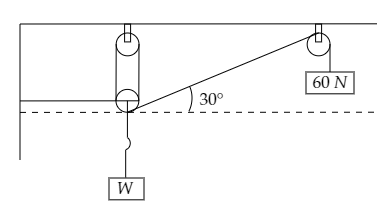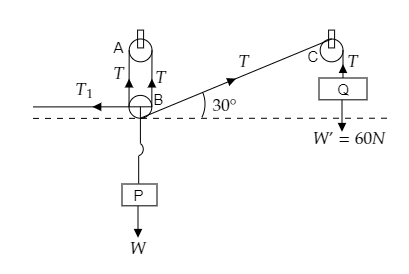Question
Question: If the system shown in the figure is in equilibrium, then calculate the value of the weight \(W\) . ...
If the system shown in the figure is in equilibrium, then calculate the value of the weight W . Assume pulleys to be weightless and frictionless.

Solution
Here two blocks of weight 60N and W are shown to be hanging using three pulleys. Tensions will exist in the ropes connected to the pulleys to which the blocks are attached. The value of tension will be the same for the same rope. Since the system is said to be in equilibrium, the tension acting in the vertical direction and the horizontal direction will be balanced by the weights of the two blocks.
Complete step by step answer:
Step 1: Sketch the given system expressing the tension in each rope attached to the wheel of the pulley.
In the given system, three wheels A, B and C along with two ropes make up the pulleys used to hang the two blocks P and Q. The tensions in the ropes connected to block P are T and T1 while the tension in the rope connected to block Q is T.
The weight of block P is given to be W and it is to be determined.
The weight of block Q is given to be W′=60N.
Step 2: Express the force balance equation in the x-direction and the y-direction.
First, we can resolve the tension in the inclined rope connecting wheels B and C into its horizontal component and its vertical component. This is shown in the figure below.
Then along the x-direction, the force balance equation for block P can be expressed as T1=Tcos30∘ .
Along the y-direction, the force balance equation for block P can be expressed as
T+T+Tsin30∘=W
⇒2T+2T=W -------- (1)
Now along the y-direction, the force balance equation for block Q can be expressed as T=W′=60N .
So the value of the tension T=60N .
Substituting for T=60N in equation (1) we get, W=(2×60)+(260)=150N
∴ the weight of the block is obtained to be W=150N .
Note: For a system to be in equilibrium, all the forces acting on it must sum up to zero. This implies that the tension in the ropes for each block along the vertical and horizontal direction gets balanced by the weight of the respective blocks. This is expressed by the force balance equations. However, the force balance equation along the horizontal direction is not necessary to solve the problem. The tension will be always directed away from the weight and so we have T1 to be directed towards the left and T to be directed upwards.
